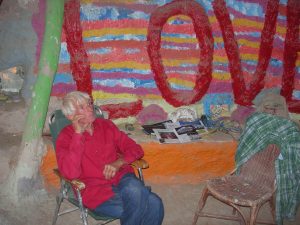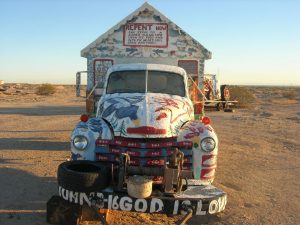“Say Jesus I’m a sinner please come upon my body and into my heart.”

At 10:30 on a Wednesday morning, Leonard Knight found God, ironically enough while trying to escape from his sermonizing sister. Three years later, Knight saw a hot air balloon flying over his hometown of Burlington, VT, and knew how to spread his love of God to others: he’d make his own balloon and fly it across the country. As fate would have it, Knight never managed to get his balloon in the air. He traveled across the US, continually sewing the fabric of his balloon, but he gave up on his dream in Niland, California (Biography of Leonard Knight). Before he left Niland, however, Knight decided to make a “small statement.” He planned on staying in the town one week to create a small monument; however, Knight ended up dedicating the next 30 years to creating and sustaining what came to be known as “Salvation Mountain,” a creation of hay and adobe coated in more than 100,000 gallons of paint that is now considered a national treasure by the US government (“the Mountain” 2004, Toxic Nightmare).

Salvation Mountain holds conflicting meanings for the many people who visit and, according to David Chidester and Edward Linenthal, that is part of what makes the site sacred. However, if we include the analysis of Richard White, there is a different conflict in the Mountain’s history that makes it a Western sacred space. During July of 1994, local government officials hired a toxic waste specialist to examine the soil content around Salvation Mountain, claiming that it was a “toxic nightmare,” (“The Mountain” 2012). The expert claimed there were large amounts of lead and other toxic materials in the soil; however, Knight then dug samples and sent them to a private lab in San Diego. Where the government expert found toxins, the San Diego lab found none and Knight was able to continue building the Mountain.
While the various conflicts of interests help make this site sacred, they are not the only things to do so. Salvation Mountain has become the site of a modern pilgrimage, a destination for both “average” and religious tourists. The regular movement of tourists through the US, often traveling great distances to reach their destination, is a quintessential part of American civil religion and Salvation Mountain is no different. It’s why the national parks became the landmarks they are today. Much as the national parks can deliver a spiritual experience to visitors, so too can Salvation Mountain. Its very name evidences its mythology, as do the descriptions of many visitors. Senator Barbara Boxer of California describes it as a “mass of technicolor shapes” and even gives false information that furthers the mythos of Knight and his mountain. She states that Knight’s “balloon crashed into the site and he decided to stay,” a false but striking backstory (Boxer).
-Ryan Wall, December 2016
Suggestions for further reading:
- “Biography of Leonard Knight.” Salvation Mountain. Accessed December 01, 2016. http://www.salvationmountain.us/bio.html.
- “The Mountain.” (2012) Salvation Mountain, Inc. Accessed December 01, 2016. http://www.salvationmountaininc.org/LeonardKnight2.htm
- “Salvation Mountain.” Off the Map. Accessed December 3, 2016. http://www.pbs.org/independentlens/offthemap/html/travelogue_artist_10.htm.
- White, Richard. “It’s Your Misfortune and None of My Own”: A History of the American West. Norman: University of Oklahoma Press, 1991.
Featured Image: Salvation Mountain, by Brian, cropped for use here. Used according to the terms of the Creative Commons License.
Image 1: Leonard Knight, by Joe Decruyenaere. Used according to the terms of the Creative Commons License.
Image 2: Salvation Mountain, by Joe Decruyenaere. Used according to the terms of the Creative Commons License.
